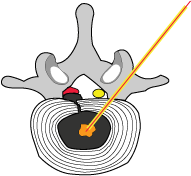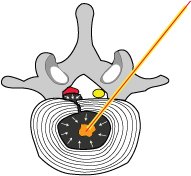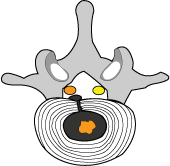Schenk B, et al (2006) Percutaneous Laser Discectomy: A Review of the Literature. AJNR; January 2006: 27; 232-235
Understanding PLDD | Visual Tutorial | The Study | Treatment Outcome | Conclusion | My Comments
Background Information:
The first percutaneous laser discectomy (a.k.a. percutaneous laser disk decompression or laser disc ablation) was attempted on a human occurred in 1986 [6], and after five short years, the procedure was approved by the US FDA. By 2002, an estimated 35,000 procedures had been performed worldwide [7]. Percutaneous laser discectomy (PLD) is one of the minimally invasive procedures designed to treat a contained lumbar disc herniation. The percutaneous approach, which is done through a hollow .5 mm needle, ostensibly decreases post-procedure morbidity secondary to the mitigation of tissue damage and blood loss. Proponents of the procedure boast a shorter patient convalescence and return to work within a few days status postprocedure. PLD has been touted as an alternative to the gold standard procedure: open discectomy (a.k.a. microdiscectomy or laminectomy with discectomy). However, there continues to be hot debate over the efficacy of PLD and many describe the procedure experimental [5].
Understanding PLD:
In order to understand the principles of PLD, one has to be familiar with the anatomy of the intervertebral disc (disc). The disc contains two principal parts that we are concerned with: the nucleus pulposus (nucleus) and the annulus fibrosis (annulus). The nucleus has an extremely high content of proteoglycans and aggrecans, both of which attract water like a sponge. Therefore, the nucleus has a very high content of water compared with the annulus. Another important principle is that the healthy disc is considered a closed hydraulic system, which is capable of supporting tremendous loads. The water rich nucleus is the star player of this hydraulic system and supports the majority of the weight of the body (axial load) single-handedly. And the more volume of nucleus there is, the higher the intradiscal pressure, which in turn leads to a higher loading capacity.
In a contained disc herniation, the closed hydraulic system of the disc has not been violated (in other words, the disc can still hold pressure); however, physical compression has occurred on the adjacent nerve root by the herniation, which in turn has resulted in radicular pain (sciatica) as well as back pain.
The theory behind PLD is this: by introducing a laser device into the nucleus pulposus and then applying laser energy (in the form of heat, which is considered an ablation), a given amount of nucleus pulposus tissue is destroyed, which in turn hinders the ability of the nucleus to hold water, which in turn decreases the intradiscal pressure. The decreased intradiscal pressure will cause the herniation to withdraw back into the disc. [1] It has been calculated that status-post PLD, the intradiscal pressure will be decreased by up to 57% [6]. It is important to understand that there is no treatment to the annulus fibrosis or the annular tear that spawned these disc herniations.
Visual Tutorial on PLD:
 |
#1) this is our starting condition: a small contained lumbar disc herniation of the L5 disc that has compressed the right L5 nerve root (the nerve root is red with inflammation and the patient has lower back pain with pain radiating down the right lower extremity). The herniation size does not take up more than one third of the central canal size – this is a criteria for PLD |

|
#2) a hollow needle (yellow) is obliquely inserted into the center of the intervertebral disc (i.e., the nucleus pulposus); this placement is confirmed by fluoroscopy and/or CAT scan guidance.
The red straight line represents a 0.4 mm laser fiber that has been inserted through the needle into the center of the nucleus pulposus. |

|
#3) laser energy is being delivered to the nucleus pulposus, which destroys the proteoglycans and aggrecan content of that tissue. This results in an immediate loss of water content as well as mass, which in turn achieves the goal of the procedure: to reduce intradiscal pressure. |

|
#4) the treatment is working as the nucleus is shrinking and the intradiscal pressure has been reduced. |

|
#5) the mass of the nucleus has been decreased as well as the intradiscal pressure. This has resulted in a retraction of the herniation, which in turn has relieved the pressure on the right L5 nerve root (orange and less angry). |

|
#6) the mass effect is no longer evident on the right L5 nerve root, which is healing and happy (yellow). |
The Study:
In 2006, Schenk B, et al published the results of their meta-analysis of the available research on PLD. More specifically, they reviewed 16 clinical trials which totaled 1597 patients, all of whom had undergone PLD for the treatment of disc herniation induced sciatica and back pain. Surprisingly, there was not a single randomized, controlled trial available (how in the world did this garner FDA approval without a randomized, controlled trial?). The authors stated, “almost all trials were case series, with a relatively low strength of evidence. Furthermore, the sample size in most trials was relatively small, resulting in broad 95% confidence intervals (CIs) that made interpretation of success rates difficult.”
All of these trials performed PLD with a similar technique: a hollow needle was inserted 10 cm from midline of the body, and then angled in toward the center of the desk. Conformation of proper positioning was accomplished by way of fluoroscopy and/or computerized tomography. Once in the center of the disc (i.e. in the nucleus pulposus), a predetermined amount of laser energy was delivered to the nucleus. A few of the studies used CT or MR imaging in order to actually visualize the amount of vaporization of the nucleus (probably a better way to go).
In order to gain entry into these studies, the patients had to demonstrate “contained” disc herniations (i.e., the herniation had not broken through the posterior longitudinal ligament) on imaging. These herniations also had to be associated with with corresponding radicular symptoms. Patients with severe neurological symptomatology (such as cauda equina syndrome); non-contained or sequestered herniations; significant disc height loss; and/or severe intractable pain were excluded.
Treatment Outcome:
The authors determined that the success rates ranged from 75% (95% confidence interval {CI}, 69%--81%) to 87% (95% CI, 80%--94%).
Between 4.4% and 25% of the patients required additional surgery via open procedure by the follow-up time point. During the open procedure most of these patients were found to have free fragments in the spinal canal. Approximately 1% of the patients suffered discitis—both aseptic and septic.
Also they noted that the single trial that used CO2 laser resulted in four cases of thermal nerve root damage, which in turn resulted in a 8% complication rate for the cohort.
Upon my review of the data in this paper, the largest study [12] consisted of 350 patients of whom only 265 (76%) reported a "successful outcome." The confidence intervals for this number was 72-80. There was a 1% complication rate (this was par for the course). We do not know how many patients were lost to follow-up and we do not know at what time point the follow-up was taken.
Conclusion:
After review of the 16 available research papers – not a single one of which was a randomized, controlled trial –the authors concluded, “Despite the fact that percutaneous lumbar disc decompression (PLD) has been around for almost 20 years, scientific proof of its efficacy still remains relatively poor, though the potential medical and economic benefits of PLD are too high to justify discarding it as experimental….” And, “Well-designed research of sufficient scientific strength, comparing PLD to both conventional surgery and conservative management of lumbar disc herniation, is needed to determine whether PLD deserves a prominent place in the treatment arsenal for lumbar disc herniation.
My Comments:
It is my personal opinion that this treatment is a real longshot. My biggest concern is the fact that PLD does not address the degenerated nuclear material that has undoubtedly worked its way into the annular tear in order to spawn the herniation. It is fairly well established that nucleus pulposus within the annular tear can chemically irritate pain fibers in the outer third of the annulus (i.e., the sinuvertebral nerves posteriorly). Without the removal of this herniated material, it is seriously doubtful that this treatment will be any more effective than just the passage of time.
The only thing I liked about the procedure was the the fact that only a tiny hole (0.05mm) was put in the disc's normal tissue, which should mitigate the amount of degenerative after-effect as a result of that puncture.
Another obvious problem with this paper was the fact that no follow-up period was given for any of the studies reviewed. In other words, we don't know how long the patients were followed after the application of the procedure. Moreover, we do not know the percentage of patients available for follow-up.
Finally The Truth Will Be Known:
It appears that we will soon learn a great deal more about the efficacy of this FDA approved treatment, for these some of the same authors have almost completed a well designed prospective, randomized, multicenter, controlled trial that compares PLD to the open microdiscectomy. A two-year follow-up will be required.(2)
So in my opinion, the jury is definitely still out on this experimental treatment, which (in my humble opinion) should never have been approved by the FDA without randomized controlled trials supporting its efficacy.
References:
1) Brouwer PA, Schenk B: Percutaneous Disc Treatment. In Imaging of the Musculoskeletal system. Edited by: Pope T, et al. Philadelphia, Saunders/Elsevier Inc; 2008.
2) Brouwer PA, et al. "effectiveness of percutaneous laser disc decompression versus conventional open discectomy in the treatment of lumbar disc herniation; design of a prospective randomized controlled trial." 2009; BMC Musculoskeletal Disorders 10:49
5) Gibson JNA, Waddell G. “surgical interventions of lumbar disc prolapse." Cochrane Database Syst Rev 2009; (1): CD001350.
Top
Copyright © 2002 – 2012 by Dr. Douglas M. Gillard DC |

